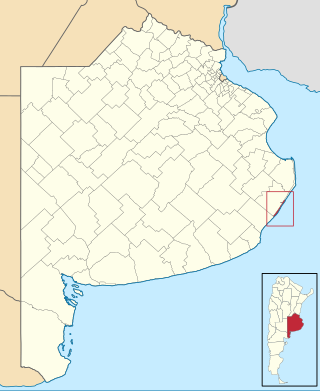
Buenos Aires, officially the Buenos Aires Province, is the largest and most populous Argentine province. It takes its name from the city of Buenos Aires, the capital of the country, which used to be part of the province and the province's capital until it was federalized in 1880. Since then, in spite of bearing the same name, the province does not include Buenos Aires city, though it does include all other parts of the Greater Buenos Aires metropolitan area. The capital of the province is the city of La Plata, founded in 1882.

Argentina has a vast territory and a variety of climates and microclimates ranging from tundra and polar in the south to the tropical climate in the north, through a vast expanse of temperate climate. Natural wonders include the Aconcagua, the highest mountain in the world outside the Himalayas, the widest river and estuary of the planet, the Iguazú Falls, the Humid Pampas, and the Argentine Sea. Visitors enjoy the culture, customs and Argentine cuisine.

La Serena is a city and commune in northern Chile, capital of the Coquimbo Region. Founded in 1544, it is the country's second oldest city after the national capital, Santiago. As of 2012, it had a communal population of roughly 200,000, and was one of the fastest-growing areas of Chile.

Maspalomas is a tourist resort in the south of the island of Gran Canaria, Canary Islands, stretching from Bahía Feliz in the east to Meloneras in the west, including the resort towns of San Agustín, Playa del Inglés and San Fernando. Maspalomas constitutes the southernmost part of the municipality of San Bartolomé de Tirajana, and of the island.

Cariló is an upscale beach resort town in Argentina. It is situated in a man made forest on the Atlantic coast of the Province of Buenos Aires, approximately 360 km south of Buenos Aires city in the administrative division of Pinamar Partido.

Pinamar is an Argentine coastal resort city located on the coast of the Atlantic Ocean in Buenos Aires Province. It has about 45,000 inhabitants (2020).

Villa Gesell Partido is a partido on the Atlantic coast of Buenos Aires Province in Argentina.

Partido de la Costa is a partido on the Atlantic coast of Buenos Aires Province in Argentina.

Pinamar Partido is a partido on the Atlantic coast of Buenos Aires Province in Argentina. It limits with La Costa Partido to the north, the Atlantic Ocean to the east, the route 11/Interbalnearia to the west, and Villa Gesell Partido to the south.

Francisco Salamone was an Argentine architect born in Italy who, between 1936 and 1940, during the Infamous Decade, built more than 60 municipal buildings with elements of Art Deco style in 25 rural communities on the Argentine pampas within the Buenos Aires Province. These buildings were some of the first examples of modern architecture in rural Argentina.

The General Roca Railway (FCGR) is a 5 ft 6 in broad gauge railway in Argentina which runs from Constitución station in Buenos Aires to the south of the country through the provinces of Buenos Aires, La Pampa, Neuquén and Río Negro. It was also one of the six state-owned Argentine railway divisions formed after President Juan Perón's nationalisation of the railway network in 1948, being named after former president Julio Argentino Roca. The six companies were managed by Ferrocarriles Argentinos which was later broken up during the process of railway privatisation beginning in 1991 during Carlos Menem's presidency.
There are a number of major football rivalries in Argentina.
Mar Azul is a small coastal settlement in Buenos Aires Province, Argentina. It is located in Villa Gesell Partido.
Costa de Oro is a 45 kilometres (28 mi) long group of resort towns and beaches in Canelones Department, Uruguay, east of the Ciudad de la Costa. Until 19 October 1994 it also included all the resorts that became henceforth integrated under the name Ciudad de la Costa. Since then, Costa de Oro contains only the resorts and locations of the area delimited by the streams Arroyo Pando to the west and Arroyo Solís Grande to the east and by the highways Ruta 8 and Ruta 9 to the north.

Provincial Route 11 is a 583-kilometre-long (362 mi) Argentine road in the East of Buenos Aires Province. The road extends from Punta Lara to the town of Mar del Sur.

Provincial Route 63 is a 29-kilometre-long (18 mi) Argentine road in the East of Buenos Aires Province. The road extends from Dolores, Buenos Aires to the "Esquina de Crotto", a paraje in Tordillo Partido.

Divisadero de Pinamar is a railway station in General Madariaga Partido of Buenos Aires Province, Argentina. The station was opened in 1996 as an extension of the General Guido – General Madariaga branch of General Roca Railway.
Ostende is a seaside resort on the Atlantic coast of Argentina belonging to the Pinamar Partido. The town limits to the north with the city of Pinamar, to the northeast with Mar de Ostende, to the south with Valeria del Mar, to the east with the Argentine Sea and to the west with General Madariaga Partido.

Juancho is a former railway station and current museum located in the General Madariaga Partido of Buenos Aires Province. The station was originally built by British-owned Buenos Aires Great Southern Railway in 1908, helping tourists reach the cities on the Atlantic coast such as Ostende, the first town established in region currently known as Pinamar Partido, and then Villa Gesell.



















